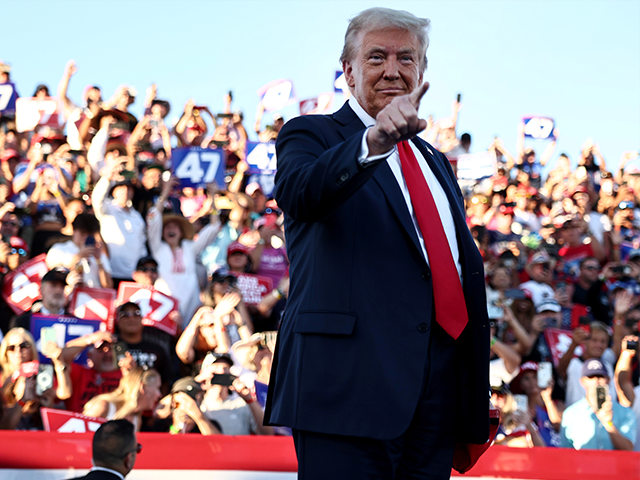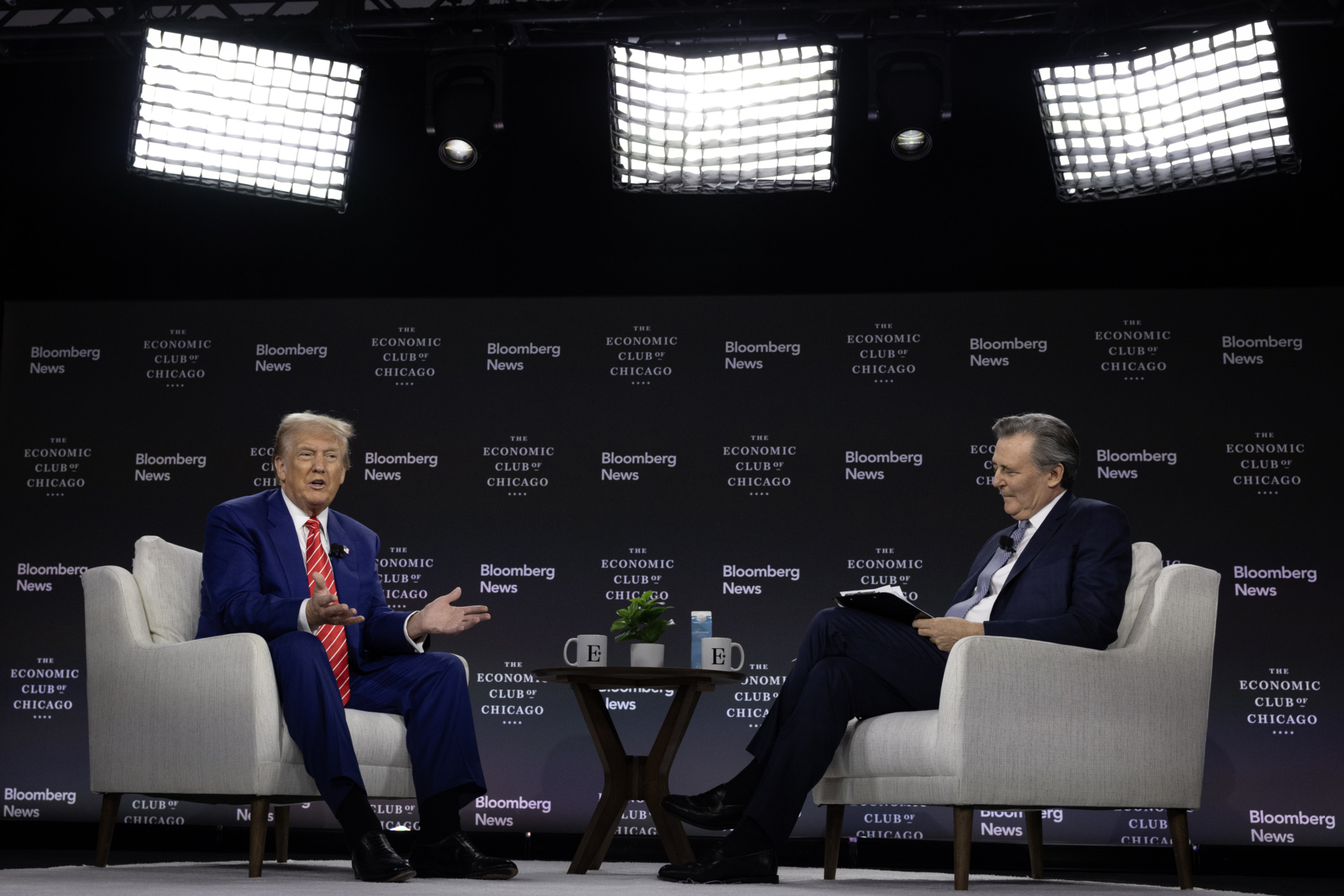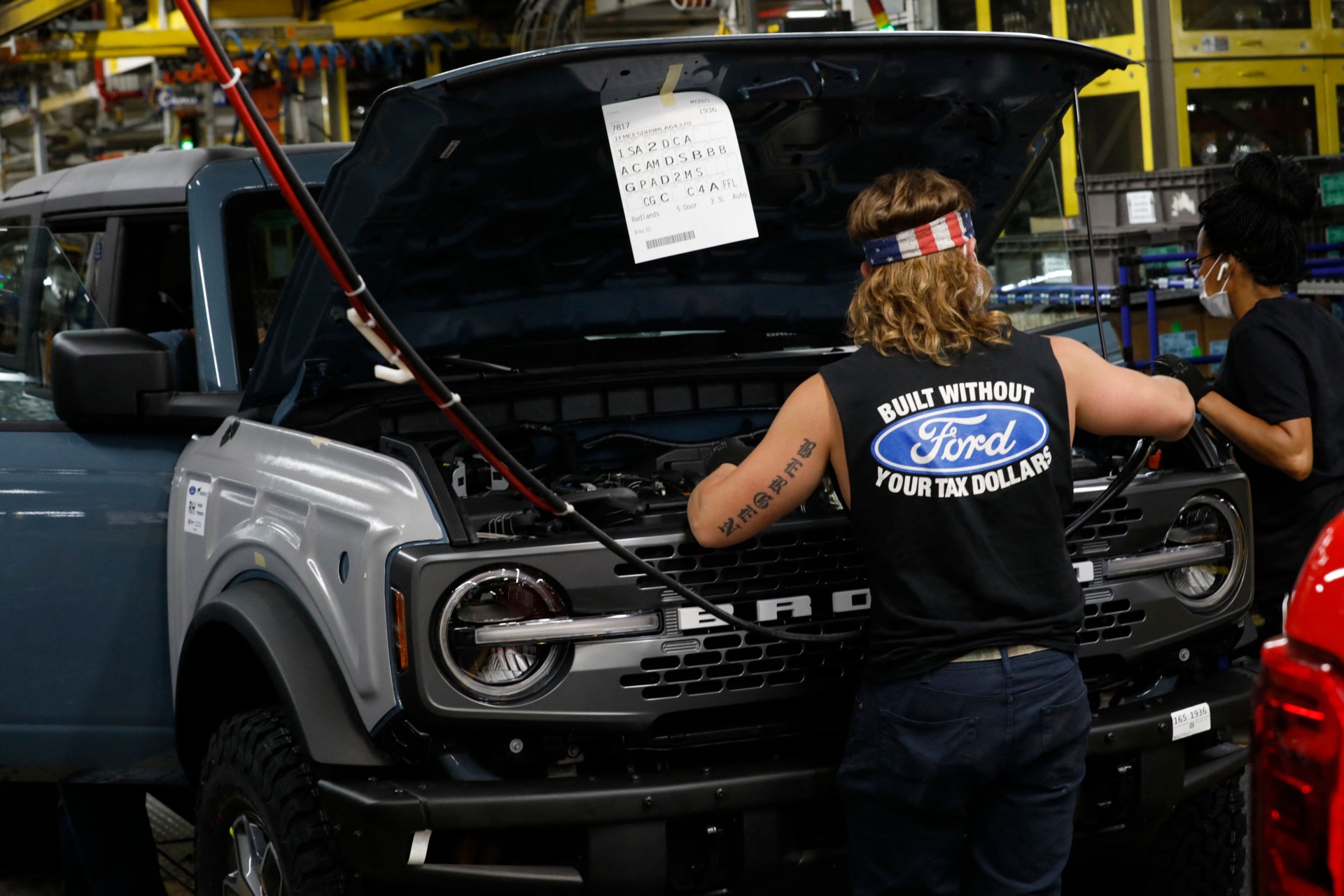Breitbart Business Digest: Trump’s New Trade Rules Shatter the Case Against Tariffs
 Mario Tama/Getty Images
Mario Tama/Getty Images
Trump’s Tariff Strategy: A New Way Forward for Trade and Innovation
Donald Trump’s Chicago speech was vintage Trump: unapologetic, combative, and unflinchingly focused on one of his favorite topics—tariffs.
In a wide-ranging conversation with Bloomberg’s John Micklethwait at the Economic Club of Chicago, Trump doubled down on his promise to levy tariffs on all imports, sparking a predictable chorus of objections from critics. But here’s the thing: Trump’s vision for tariffs—far from the straw man of “protectionism” that critics love to decry—is something new, bold, and based on a strategy that undercuts the standard arguments against tariffs.
“To me, the most beautiful word in the dictionary is ‘tariffs,’” Trump said. “It’s my favorite word.”
That line, met with applause, captures what the critics often miss. Trump’s approach to tariffs is more than a throwback to 20th-century protectionism. It’s a calculated, modern tool for reshaping global supply chains and bringing manufacturing back to U.S. soil.

Former President Donald Trump is interviewed by Bloomberg News Editor-in-Chief John Micklethwait during a luncheon hosted by the Economic Club of Chicago on October 15, 2024, in Chicago, Illinois. (Scott Olson/Getty Images)
Tariffs: A Catalyst for American Manufacturing
Critics of tariffs, like Micklethwait, are quick to warn of higher prices for consumers and potential fallout with U.S. allies. “The higher the tariff, the more you’re going to put on the value of those goods, the higher people are going to have to pay,” Micklethwait told Trump.
But Trump had a sharp response ready: “The higher the tariff, the more likely it is that the company will come into the United States and build a factory.” And this is where Trump’s critics start to lose the plot.
What Trump understands—and what those attached to the now-outdated trade paradigm are slow to grasp—is that tariffs don’t just tax imports. They change the calculus for companies deciding where to build and invest. A 10 percent tariff across the board, or even the jaw-dropping 60 percent Trump is proposing for Chinese goods, isn’t just about penalizing foreign producers. It’s about giving them a powerful incentive to relocate their production to the U.S., bringing factories, jobs, and investment along with them.
“We’re going to bring the companies back. We’re going to lower taxes for companies that are going to make their products in the USA. And we’re going to protect those companies with strong tariffs,” Trump said.
As our friend Larry Kudlow said on his Fox Business Network program, “The time has long passed in American politics where the U.S. can stand by and do nothing while our foreign competitors and adversaries take advantage of us.”
This isn’t protectionism for its own sake—this is a strategy to reignite domestic production and rebuild America’s industrial base, particularly in sectors like steel and autos, where decades of free-trade policies have hollowed out once-thriving industries.
Undercutting the Critics on Innovation and Competition
One of the standard objections to tariffs is that they stifle competition and innovation. The argument goes that when domestic companies are shielded from foreign rivals, they grow complacent, stop innovating, and raise prices. But Trump’s vision turns this argument on its head. By coaxing foreign companies to move production to the U.S., tariffs bring new competition into the domestic market, rather than insulating it.
Take the auto industry, which Trump often cites. If foreign carmakers like Toyota and Volkswagen build their plants in the U.S. to avoid tariffs, they aren’t just adding capacity—they’re competing head-to-head with domestic companies like Ford and General Motors. This is the kind of competition that spurs innovation and keeps prices in check. Tariffs, in this context, don’t shut down global competition; they localize it, bringing the battle to U.S. soil and ensuring that American consumers benefit from a vibrant, competitive market.

American autoworkers assemble a Ford Bronco at the Ford Motor Company’s Michigan Assembly Plant in Wayne, Michigan, on June 14, 2021. (JEFF KOWALSKY/AFP via Getty Images)
The critics will still complain, but Trump’s response to Micklethwait highlights why they’re missing the point.
“You see these empty, old, beautiful steel mills and factories that are empty and falling down,” Trump said. “We’re going to bring the companies back.”
The old argument that tariffs inevitably lead to higher prices and stagnant industries no longer holds when you consider that Trump’s goal is to attract investment, not to insulate inefficiency.
A New Trade Paradigm, Not a Trade War
Trump’s critics, especially those in the economic establishment, love to point out that tariffs could anger U.S. allies. Micklethwait noted that Trump’s economic proposals would target not only adversaries like China but also American allies, raising concerns about strained relationships.
But at its core, Trump’s tariff plan isn’t about provoking endless trade wars or jeopardizing diplomatic relationships. It’s about putting American workers first by using the immense leverage of the U.S. market to bring foreign countries to the table. Our trading partners, who have long benefited from near-unrestricted access to American consumers while shielding their own markets with tariffs and subsidies, value that access too much to risk a prolonged conflict.
The reality is that America’s trading partners are unlikely to fight a drawn-out trade war. Why? Because the U.S. market is simply too important to them. They rely on American consumers for their economic growth, and they can ill afford to be locked out. Trump’s strategy, rather than isolating the U.S. or damaging alliances, is designed to convince these countries to reconsider their own trade barriers. Faced with the prospect of losing access to the world’s largest market, they’ll be incentivized to invest in the U.S. and open their markets to American products in return.
The goal isn’t to alienate foreign governments, but to secure a fairer deal for American workers and businesses. Tariffs aren’t a threat—they’re a bargaining chip. By pushing foreign companies to build factories in the U.S. and encouraging our trading partners to drop their own tariffs and subsidies, Trump’s strategy can foster more balanced, mutually beneficial trade relationships. And in the end, that’s likely to lead to more cooperation, not less.
“Reciprocity is the new free trade,” Kudlow said the day after Trump’s Chicago chat. “Ironically, the very tariffs that the liberal economic establishment hates so much are the pathway to free trade.”
The Case for Smart Tariffs
Trump’s tariff plan is a far cry from the crude protectionism his critics make it out to be. It’s a smart, strategic approach to recalibrating global trade relationships in a way that benefits American workers, companies, and consumers.
In Trump’s vision, tariffs aren’t a blunt tool of economic isolation—they’re a weapon in a larger strategy to reclaim American sovereignty and build a more self-reliant economy. By convincing companies to invest in the U.S., creating a competitive market at home, and renegotiating trade deals on American terms, Trump’s tariffs offer a bold alternative to the old establishment trade orthodoxy that the American people have cast into the ash heap of history.
It’s a strategy that puts America first—just as it should be.
Source link

